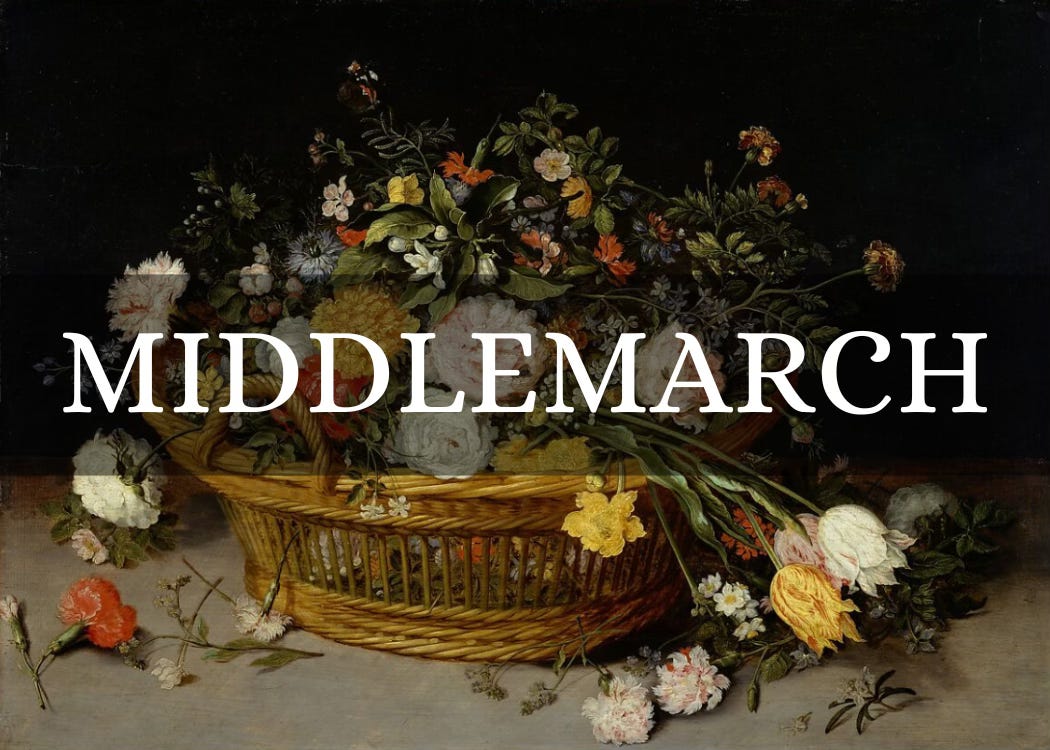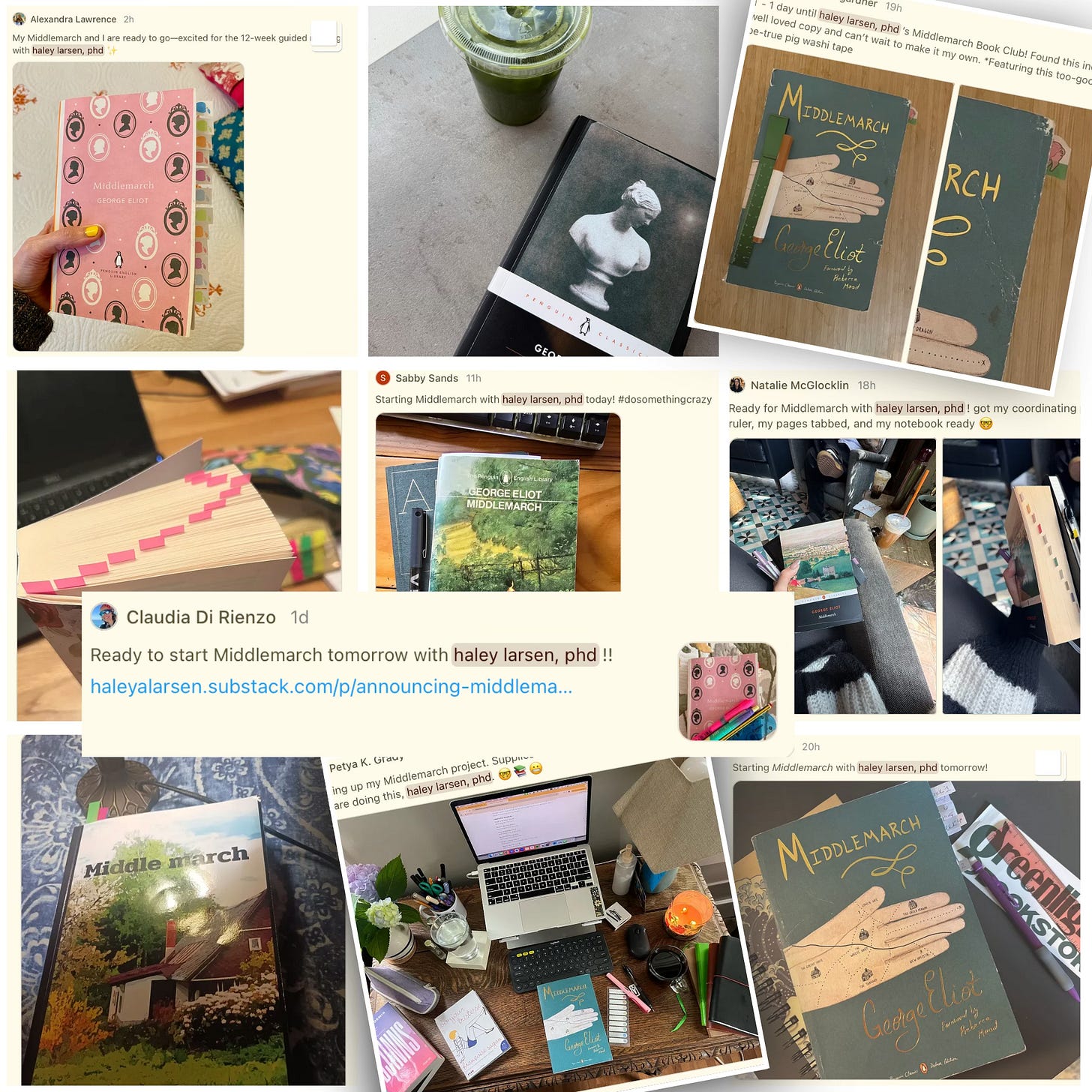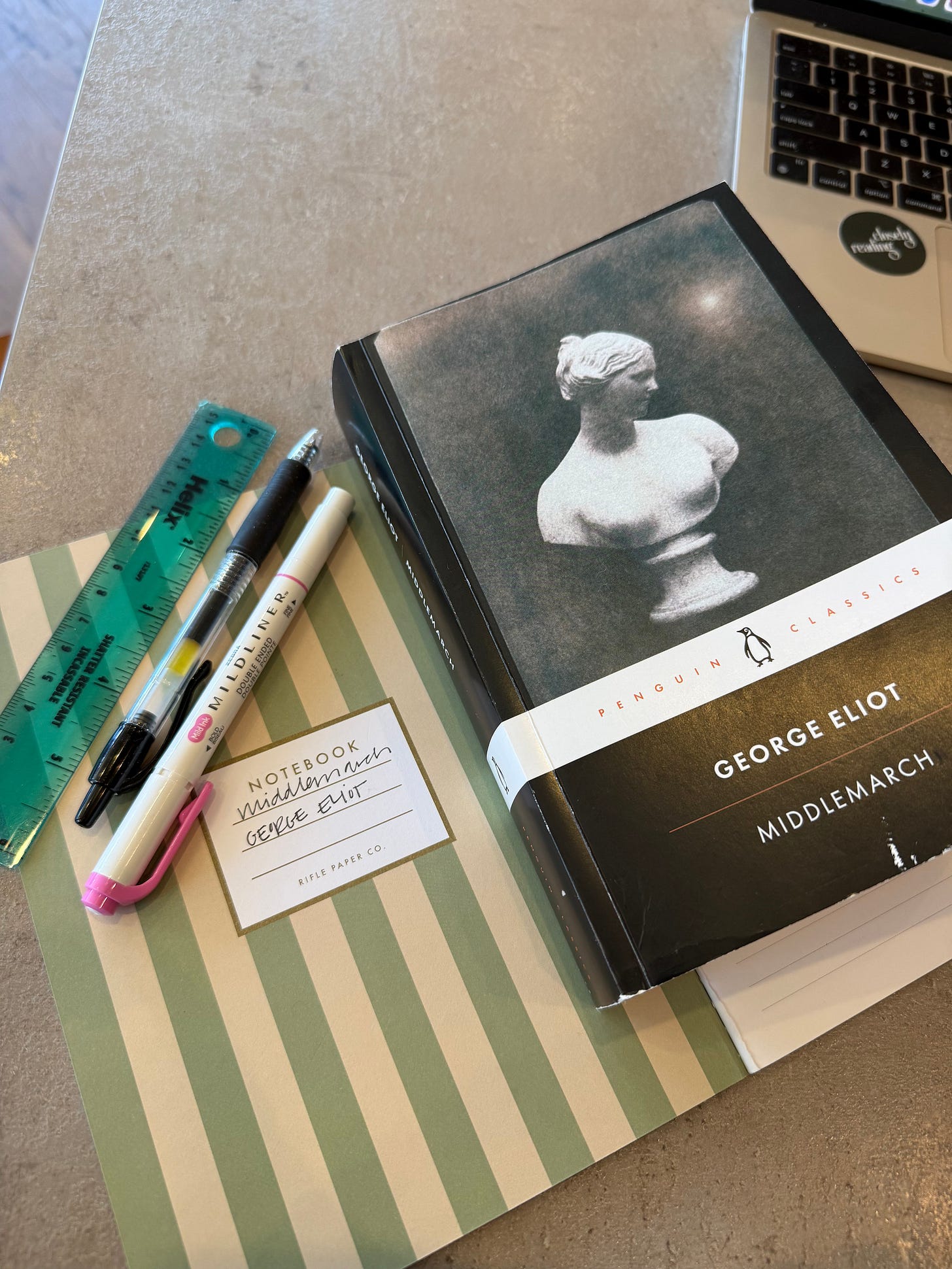welcome to Middlemarch
Week 1 | The prelude, chapter 1, and getting into a very big book
Welcome to the Closely Reading book club: a space where we closely read classic literature together and discuss assigned chapters each week. We’re currently reading Middlemarch and you’re welcome to join us at any time.
Welcome to week 1
In these read-a-long experiences, we love to start things slow with just a single chapter during the first week.
Middlemarch is already quite unique—it begins with a doubled opening. A prelude and chapter 1.
Read both this week: the Prelude and Chapter 1.
…And that’s it. That’s all you need to do this week to get started!
In today’s post, I offer some questions about how to read the first lines of the novel, share my bookish setup with you (along with some of your fellow readers!, and also give you some questions to tuck into your back pocket as we move deeper into the reading.
It’s all gloriously spoiler free.
Let’s dive in!
The first lines
If you’ve been here before, you know we love a first line.
In fact, the first lines of novels like Middlemarch often function as a kind of microcosm for the novel as a whole. That is, the first line tells us a lot about what to expect from the rest of the story. And in the case of Eliot’s novel here, we essentially get two first lines.
Here’s how the Prelude begins —
And here’s the first sentence of chapter 1 —
As you read, it’s worth resting on each of these lines.
Compare them.
How are they working similarly? How are they working independently?
Does the narrator of each line feel distinct? Or is this obviously the same narrator?
How do you know?
How does the tone change from one line to the next? Does it change? In what ways? Where — in the individual words — do you see those changes?
From the universal to the particular
The first thing I notice, placing these lines side-by-side, is that Eliot moves us deftly from the universal question of “the history of man,” to the individual and particular of “Miss Brooke.” This is a rapid zooming—a philosophical shift from reading the whole of history of mankind to learning about the particular style, or dress, of a single woman.
I think: that’s cool.
I also think: that kinda reminds me of what Austen does in Pride & Prejudice.
Of course, Austen’s famous first line of P&P is that of the supposedly universal law that governs the Bennet family’s marriage plot:
Here, Austen tells us basically everything we need to know about the novel. It sets the plot in motion while also setting our expectations — this will be a novel about how single men, with good fortunes, end up with wives.
The first line invites us to ask: Is it really universal? Is truth just what everyone acknowledges? What kind of wives? What does it mean to possess? To be possessed? To be “in want” in a book about romance?
How are Eliot’s first lines similarly operating?
That is: how are Eliot’s lines also starting to tell us the laws of the narrative’s world? What rules or social dynamics are at play here? Do we know yet? Are we being asked to pay attention to anything specific yet?
I invite you to use your notebook or the blank pages in the front of your copy of the novel or in your digital note taking tool to jot down some thoughts based solely on these first lines.
What do the first lines set in motion?
How?
What questions do they make you ask?
Why?
(This is closely reading! You’re off to the races!)
Next week
Next Monday, I’ll share the analysis of these opening lines along with my close reading of the prelude + chapter 1 with you. So, each week, you’ll enter a spoiler-free space that summarizes what you’ve read the week before and kicks us off into the next section.
I want to ask: Should I put up a simple “Discussion Post” each week, so you can leave comments to each other before the guide comes out? Or do you want to wait and put it on each guide?
If you’ve read with me before, this is an evolution of the previous format, where we discussed the week’s pages during that week. However, I often found that most folks waited until later in the week, or even the next week, to open the post + share their thoughts in the comments, because they spent the week getting the reading done, which makes so much sense. So—please let me know how this new way of rolling out the analysis works for you!
Our community
I have *loved* seeing everyone’s reading materials and setups as we get started. Check out my Notes to see lots of re-posts from your fellow Close Readers! And if you share about your Middlemarch reading experience, please please please tag me in a note or link me to your Substack so I can share.
Cheers to Petya, Natalie, Claudia, Alexandra, Sabby, Lauren, and everyone else who tagged me in to see their setup!
Here’s my setup, as we get started — I’ve got my trusty 6-inch ruler, a favorite Mildliner highlighter, a fresh Pilot G-2 .05 black ink pen, and a lovely little notebook from Rifle Paper Co. that I’ll be using as my read-a-long journal.
I am realizing that I like a thin softcover or paper-cover notebook of around the same size as the novel I’m reading, so that I can tuck it into the book for easy packing into my bag each day. This is the exact set I have from Rifle Paper Co. and I just love how thin they are, without sacrificing any material quality. The paper is smooth; the covers are really pretty, and I like the thickness of each page so I can make messy notes and highlights in my own notes without bleeding through.
In a departure from my usual preference for dotted or blank paper, I really like the lined paper in these notebooks. It helps me keep my notes for writing each week’s post a lot more tidy.
No, this is not sponsored or anything. (I wish! Maybe someday!) I just love these notebooks!
This is my first time reading this novel, and so in addition to the typical deeper analysis I provide each week, I’m going to strike a balance between sharing academic-ish insights (along with citations for you!) and my own observations of what I noticed while reading that week’s assigned pages.
I also invite you to share what you notice in the comments each week. Here are some things you might focus on as you read, to help you “notice” details and story in the novel at a deeper level:
What do you notice about the craft of the novel? Think: sentence structure, vocabulary, and pacing.
What do you notice about the characters in the novel? Think: behavior, motivations, descriptions, dialogue.
What do you notice about the setting of the novel? Think: landscapes, architecture, weather.
What do you notice about yourself as you’re reading? Are you bored, tired, excited, enthralled?
I’m taking and responding to reader questions as we go along. And there’s no such thing as a stupid question.
You can submit all your questions here.
This is an excellent way to get more involved in the story and it’s always a very safe space to share where you’re getting confused or lost. I will, to the best of my abilities, work to answer your questions!
So let’s get started!
Read the Prelude + chapter 1, and I’ll be back next Monday with a fuller guide to these introductory pages — and a tee-up into our next week of pages.
Tag me here on Substack and/or find me on Instagram to share your images and your notes as you get started.
I’m so excited to read with you!
My little pitch for paid subs
Paid subscriptions help me keep our read-a-longs accessible to all readers, and the new tiered structure makes it even easier for readers to opt-in at the level right for their wallets and their families.
Each week, I dedicate time not just to reading along with everyone, but also to crafting the guidance and insights I hope will be helpful to you on your reading journey.
My goal is not to demystify everything for you, nor is it to have all the answers (after all, this is my first time with Middlemarch, too!). Though, I bring my own knowledge and academic training to help us track down answers to the questions that riddle us as we read.
My real goal is to help you become a closer reader.
I genuinely believe that the best way to do that is to undertake a difficult reading project, like a massive novel from the 19th century.
You’ll stretch your brain.
You’ll learn a lot about the nineteenth century.
And maybe a little bit about yourself, too.
I hope you will notice things you may not have noticed before—this is, after all, where our brains grow. When we stretch into new places, notice new dimensions, and give ourselves the opportunity to take a passion project a little more seriously.
This summer, in this read-a-long, you’ll spend dedicated time with an amazing writer and a beloved story. And you’ll get to do it all with our incredible community.
Here are all your options — all unlock the same benefits.
$15 per year
Get a full year of Closely Reading for $15. Available to all readers, all the time.$25 per year
Get a full year of Closely Reading for $25. Available to all readers, all the time.$50 per year
Get a full year of Closely Reading for $50. Available to all readers, all the time.$100 per year
Founding member status, or status as a “Patron of Literary Arts” is the highest paid tier possible—available for anyone who wants to opt-in at this level.











I like the comparison of the first lines of the prelude and chapter 1 to that of the universal to the particular. P&P is mentioned as a similar example, it also makes me think of the opening paragraphs to Their Eyes Are Watching God by Zora Neale Hurston – the opening lines start with the wishes and dreams of men, the reality of women’s thoughts, and then we zoom in on Janie Crawford as she returns from her own journey of love, adventure, and dreams deferred.
Whilst reading up on St Theresa de Avila, there is the spooky coincidence of her tomb being reopened today for visitors to see her remains for only the 2nd time in 400 years! https://news.sky.com/story/display-of-saints-remains-draws-huge-crowds-but-bishop-says-it-encourages-morbid-curiosity-13374993